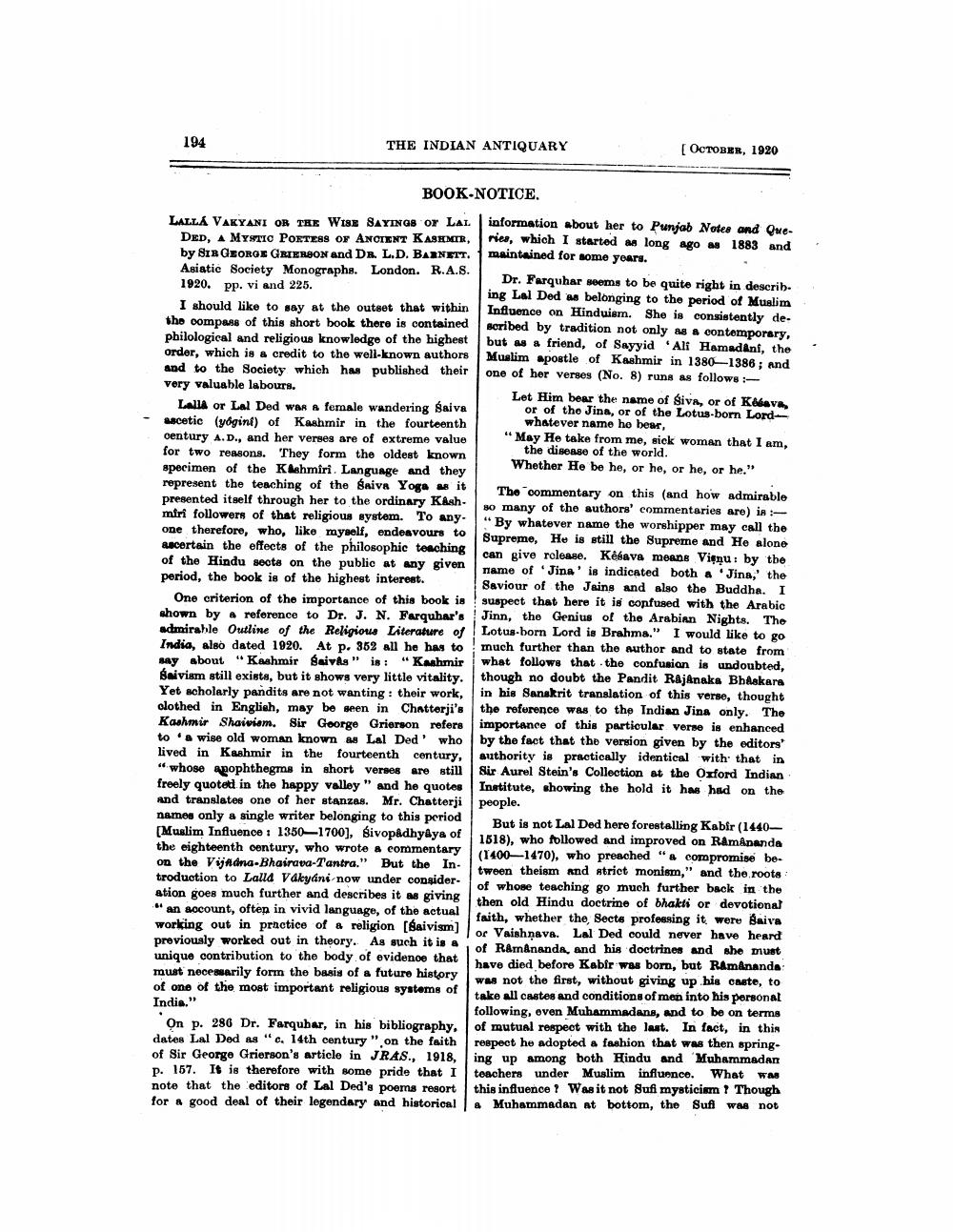________________
194
THE INDIAN ANTIQUARY
OCTOBER, 1920
BOOK-NOTICE.
LALLA VAKYANI OR THE WE SAYINGS or LAL information about her to Punjab Notes and Que
DED, A MYSTIC PORTES OF ANCIENT KASHMIR, mies, which I started as long ago as 1883 and by SIR GEORGE GRIERSON and DR. L.D. BARNETT. maintained for some years. Asiatic Society Monographs. London. R.A.S.
Dr. Farquhar seems to be quite right in describ1920. Pp. vi and 225.
ing Lal Ded as belonging to the period of Muslim I should like to say at the outset that within Influence on Hinduism. She is consistently dethe compass of this short book there is contained Boribed by tradition not only as a contemporary, philological and religious knowledge of the highest but as a friend, of Sayyid Ali Hamadani, the order, which is a credit to the well-known authors Muslim apostle of Kashmir in 1380—1386 ; and and to the Society which has published their one of her verses (No. 8) runs as follows: very valuable labours.
Let Him bear the name of Siva, or of Kebave, Lalla or Lal Ded was a female wandering saiva or of the Jins, or of the Lotus-born Lord ascetic (yogini) of Kashmir in the fourteenth
whatever name ho bear, century A.D., and her verges are of extreme value
"May He take from me, sick woman that I am, for two reasons. They form the oldest known
the disease of the world. specimen of the Kashmiri Language and they
Whether He be he, or he, or he, or he." represent the teaching of the saiva Yoga as it
The commentary on this (and how admirable presented itself through her to the ordinary Kash
30 many of the authors' commentaries are) in :miri followers of that religious system. To any.
"By whatever name the worshipper may call the one therefore, who, like myself, endeavours to
Supreme, He is still the Supreme And He alone ascertain the effects of the philosophic teaching
can give release. Kébava means Vienu : by the of the Hindu sects on the public at any given
name of 'Jina' is indicated both a 'Jina,' the period, the book is of the highest interest.
Saviour of the Jains and also the Buddha. I One criterion of the importance of this book is suspect that here it is confused with the Arabic shown by reference to Dr. J. N. Farquhar's Jinn, the Genius of the Arabian Nights. The admirable Outline of the Religious Literature of Lotus-born Lord is Brahma." I would like to go India, also dated 1920. At p. 352 all he has to much further than the author and to state from say about "Kashmir Saivis" is : "Kashmir what follows that the confusion is undoubted, Saivism still exists, but it shows very little vitality. though no doubt the Pandit Rajanaka Bhaskara Yet scholarly pandits are not wanting: their work, in his Sanskrit translation of this verse, thought olothed in English, may be seen in Chatterji's the reference was to the Indian Jins only. The Kashmir Shaiviam. Sir George Grierson refers importance of this particular verse is enhanced to a wise old woman known as Lal Ded' who by the fact that the version given by the editors' lived in Kashmir in the fourteenth century, authority is practically identical with that in "whose apophthegms in short verses are still Sir Aurel Stein's Collection at the Oxford Indian freely quotet in the happy valley" and he quotes Institute, showing the hold it has had on the and translates one of her stanzas. Mr. Chatterji names only a single writer belonging to this period
But is not Lal Ded here forestalling Kabir (1440— (Muslim Influence : 1350-1700), Bivopadhyaya of
1618), who followed and improved on RamAnanda the eighteenth century, who wrote a commentary
(1400—1470), who preached "& compromise beon the Vijana.Bhairava-Tantra." But the In
tween theism and strict monism," and the roots troduction to Lalld Vákyani now under consider
of whose teaching go much further back in the ation goes much further and describes it as giving
then old Hindu doctrine of bhakti or devotional "an socount, often in vivid language, of the actual
faith, whether the, Sects professing it were Baiva working out in practice of & religion (Saivism)
lor Vaishnava. Lal Ded could never have heard previously worked out in theory. As such it is a
of Ramananda, and his doctrines and she must unique contribution to the body of evidenoe that
have died before Kabir was born, but RamAnanda muat necessarily form the basis of a future history
was not the first, without giving up his caste, to of one of the most important religious systems of
take all castes and conditions of men into his personal India."
following, oven Muhammadans, and to be on terms On p. 286 Dr. Farquhar, in his bibliography, of mutual respect with the last. In fact, in this dates Lal Ded as "c. 14th century" on the faith respect he adopted a fashion that was then springof Sir George Grierson's article in JRAS., 1918, ing up among both Hindu and Muhammadan p. 157. It is therefore with some pride that I torchers under Muslim influence. What was note that the editors of Lal Ded's poems resort this influence? Was it not Sufi mysticism? Though for a good deal of their legendary and historical & Muhammadan at bottom, the Sufi was not




